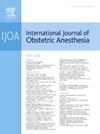Pre-oxygenation using high flow humidified nasal oxygen or face mask oxygen in pregnant people – a prospective randomised controlled crossover non-inferiority study (The HINOP2 study)
IF 2.6
3区 医学
Q2 ANESTHESIOLOGY
引用次数: 0
Abstract
Background
Airway guidelines recommend pre-oxygenation of obstetric patients to an end tidal oxygen concentration (etO2) ≥90%. High flow nasal oxygen (HFNO) achieves this in 60% of pregnant people. However face mask (FM) pre-oxygenation also may not achieve this target in all patients. In this study we determined whether HFNO pre-oxygenation is non-inferior to FM pre-oxygenation.
Methods
This randomised controlled crossover non-inferiority trial was conducted on healthy participants of gestational age ≥37 weeks in a simulated environment. Participants underwent pre-oxygenation for three minutes with HFNO and FM oxygen in randomised order. HFNO was delivered at a maximal flow of 70 l.min-1 and FM oxygen at 10 l.min-1. The primary outcome was etO2 on first expired breath after pre-oxygenation. Non-inferiority was defined as a mean difference in first etO2 between groups of ≤5%.
Results
Seventy participants were randomised with 62 analysed. Age (mean (SD)), gestation (median (IQR)), and body mass index (median (IQR)), were 34.7 (4.6) years, 39 (38.4, 39.4) weeks, 29 (26.6, 32.4) kg.m-2 respectively. First etO2 after HFNO pre-oxygenation was greater than after FM pre-oxygenation (HFNO pre-oxygenation mean (SD) 90.2 (3.9)% versus FM pre-oxygenation 88.7 (3.0)%; mean difference = 1.45%, 95% CI 0.19 to 2.72%; p = 0.025. Forty-four (71%) participants achieved ≥90% first etO2 concentration after HFNO pre-oxygenation versus 27 (44%) after FM pre-oxygenation (p = 0.002).
Conclusions
In this cohort of pregnant people at term in a simulated environment, pre-oxygenation with HFNO was not inferior to FM pre-oxygenation. FM pre-oxygenation did not achieve pre-oxygenation targets in over 50% of participants.
孕妇使用高流量鼻氧或面罩氧进行预吸氧--前瞻性随机对照交叉非劣效研究(HINOP2 研究)
背景气道指南建议对产科病人进行预吸氧,使潮气末氧浓度(etO2)≥90%。高流量鼻氧 (HFNO) 可使 60% 的孕妇达到这一目标。然而,面罩(FM)预吸氧也不一定能使所有患者达到这一目标。在这项研究中,我们确定了高流量鼻氧预吸氧是否不劣于调频预吸氧。方法这项随机对照交叉非劣效性试验是在模拟环境中对孕龄≥37 周的健康参与者进行的。参与者按随机顺序接受高频硝化氧和调频氧预吸氧三分钟。高频硝化氧的最大流量为 70 升/分钟,调频氧的最大流量为 10 升/分钟。主要结果是预吸氧后第一次呼气时的 etO2。非劣效性的定义是组间首次等氧饱和度的平均差异≤5%。年龄(平均值(标清))、孕期(中位数(IQR))和体重指数(中位数(IQR))分别为 34.7 (4.6) 岁、39 (38.4, 39.4) 周和 29 (26.6, 32.4) kg.m-2。HFNO 预吸氧后的首次等氧饱和度高于 FM 预吸氧后(HFNO 预吸氧平均值(标清)90.2 (3.9)% 对 FM 预吸氧 88.7 (3.0)%;平均差异 = 1.45%,95% CI 0.19 至 2.72%;P = 0.025)。结论 在模拟环境中对这组临产孕妇进行高频硝化氧预吸氧并不比调频预吸氧差。调频预吸氧在 50% 以上的参与者中无法达到预吸氧目标。
本文章由计算机程序翻译,如有差异,请以英文原文为准。
求助全文
约1分钟内获得全文
求助全文
来源期刊
CiteScore
4.70
自引率
7.10%
发文量
285
审稿时长
58 days
期刊介绍:
The International Journal of Obstetric Anesthesia is the only journal publishing original articles devoted exclusively to obstetric anesthesia and bringing together all three of its principal components; anesthesia care for operative delivery and the perioperative period, pain relief in labour and care of the critically ill obstetric patient.
• Original research (both clinical and laboratory), short reports and case reports will be considered.
• The journal also publishes invited review articles and debates on topical and controversial subjects in the area of obstetric anesthesia.
• Articles on related topics such as perinatal physiology and pharmacology and all subjects of importance to obstetric anaesthetists/anesthesiologists are also welcome.
The journal is peer-reviewed by international experts. Scholarship is stressed to include the focus on discovery, application of knowledge across fields, and informing the medical community. Through the peer-review process, we hope to attest to the quality of scholarships and guide the Journal to extend and transform knowledge in this important and expanding area.

 求助内容:
求助内容: 应助结果提醒方式:
应助结果提醒方式:


